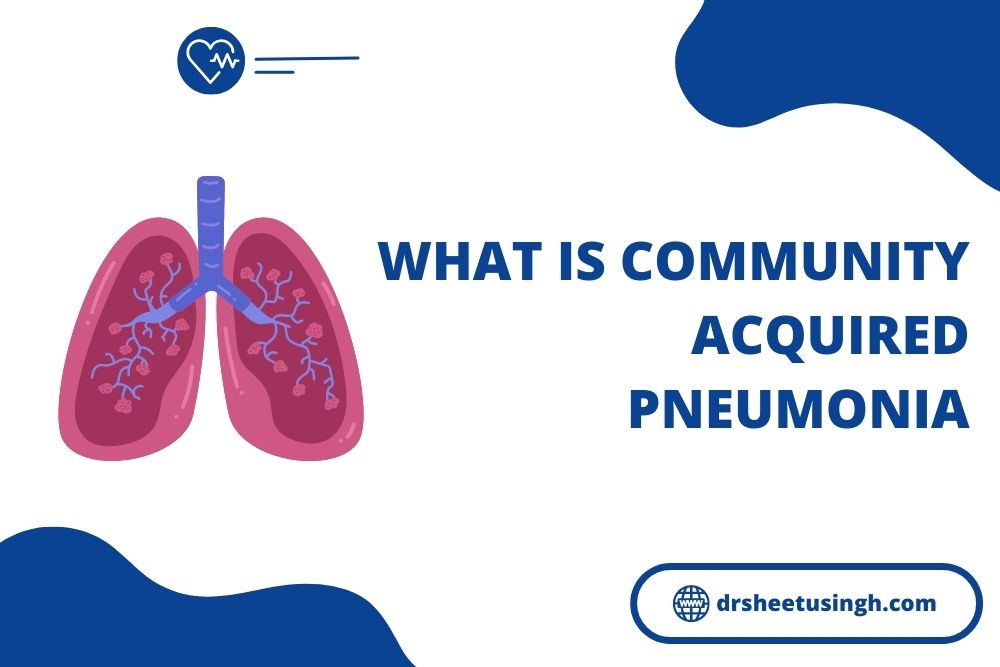What Is Community Acquired Pneumonia

Community acquired Pneumonia or CAP is also pneumonia, but is caused outside the hospital, and is acquired outdoors in the public. So, People who have not been to any healthcare facility recently can acquire pneumonia from other sources outside the hospital premises. Pneumonia is an infection caused in the lungs and affects normal breathing, leading to difficulties in usual respiratory health. This infection inflames the air sacs of our lungs. The lungs are the site of the exchange of gases, intake of oxygen and removal of carbon dioxide. The inflamed air sacs find it difficult to perform their routine function. The inflammation is accompanied by the deposition of fluids inside the air sacs of the lungs.
What Is Community Acquired Pneumonia – Dr Sheetu Singh
Bacterial pathogens are present in the air around us, being microorganisms that can easily thrive in the environment around us. Different bacteria can cause pneumonia in adults, that includes, Streptococcus pneumoniae and Haemophilus influenzae. Influenza viruses, Adenoviruses and Coronaviruses can also induce pneumonia in people. Pneumonia caused by the pathogens can be fatal and serious. These pathogens are released in the air during coughing or sneezing in droplets and can be inhaled by a healthy person. So, the droplets contain the causative organism and can infect the person inhaling it, making the disease contagious.
Symptoms of CAP: –
Typical symptoms of community-acquired pneumonia include:
- Fever
- Coughing
- Chest congestion and pain
- Dyspnea
- Nausea
- Diarrhea
Atypical symptoms can vary from person to person and is different in adults and children too.
Adults experience symptoms such as nails and lips turning blue because of lack of oxygen in the blood, restlessness, sound while breathing, and excessively thick and sticky mucus.
Diagnosis: –
Fatality is the biggest threat in respiratory diseases, as the lungs are the primary site for controlling breathing patterns. If there is not enough oxygen being supplied to the body, there are chances of failure of the organs and their activities. A pulmonologist can advise, based on the symptoms, whether or not the disease falls in the category. Yet, diagnostic tests are required for a confirmed prognosis.
The tests include the following methods:
- Chest X-Ray
- CT scan
- Blood tests for a primary check-up.
- Blood pressure and oxygen levels.
- Blood culture for etiology
- Sputum sampling for exact pathogenic identification.
- COVID-19 tests
Who is at risk?
Certain people are more at risk than others. Some of the conditions are as follows:
- People with weak immunities are more prone to the disease as their immune systems fail to eliminate the causative organism.
- Smokers have a higher chance of getting infections in their lungs.
- COPDs also increase the chances.
- Problems such as kidney failure.
Treatment:
Experts, after a confirmed diagnosis of the disease, can advise a person to be put on antibiotics. These anti-bacterial agents can help to eliminate the pathogen if at all it is caused by a bacterium. The type of antibiotic depends upon the cause of the disease. Then, medication is accompanied by certain therapies or even surgery if needed. If the lungs are severely damaged because of the infection, surgeries might be a help.
Oral medication takes a long time to completely cure the disease, but the effects can be seen within a few days after the start of the medication.
People with a high risk of fatality are also put on a ventilator for extra support.
Precautions:
There are certain precautionary measures which are suggested by Dr Sheetu Singh, that we need to follow, especially if we are infected.
- Avoid crowded places to avoid catching the microbes causing the infections and the ones suffering from it might not spread it to others.
- Do not avoid medication to eliminate the infection from our lungs.
- Wear masks to prevent it from spreading.
- Take warm liquids to keep our throat healed and moist.
- Complete the course of antibiotics.
- Take a balanced diet to improve your immunity.

